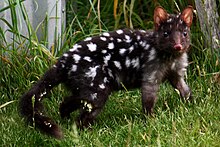Spotted pouch marten
| Spotted pouch marten | ||||||||||||
|---|---|---|---|---|---|---|---|---|---|---|---|---|

Spotted pouch marten ( Dasyurus viverrinus ) |
||||||||||||
| Systematics | ||||||||||||
|
||||||||||||
| Scientific name | ||||||||||||
| Dasyurus viverrinus | ||||||||||||
| Shaw , 1800 |
The spotted sacred marten or Eastern sacred marten ( Dasyurus viverrinus ) is a species from the predator family .
features
This species reaches a head trunk length of 28 to 45 cm with a weight of 700 to 2000 g. The males are usually slightly larger and heavier than the females. There are two color forms next to each other. The top of the lighter one is light brown, that of the dark one is black. Both forms have the large white spots on the upper side, which are typical for this genus; the tail of the spotted marten is not spotted, the hind feet have only four toes.
distribution
Originally, the spotted sacred marten was widespread in southeastern Australia from eastern South Australia to northern New South Wales and Tasmania . At the beginning of the 20th century, the population size fell sharply, probably due to an epidemic, but also because of new enemies such as introduced foxes and feral domestic cats . Since then, no more animals have been detected on the mainland, so that the spotted sacred marten is only found on Tasmania and the islands of the Bass Strait today . In Germany they are only kept in Frankfurt Zoo and Leipzig Zoo .
In 2018, 20 spotted sacred martens from farms in Tasmania were released into the wild in Booderee National Park in Jervis Bay Territory . Many of the animals did not survive, but three females produced offspring. The animals were provided with transmitters. In 2019, 40 more animals, some from the Australian Reptile Park north of Sydney, were added. Ten poached martens from this zoo were also released into the wild in a fenced area in the Barrington Tops National Park.
habitat
Bushland, dry forests, but also cultivated land are used as living space. The highest stand densities are achieved in eucalyptus forests with adjacent pastureland.
Way of life
Spotted martens live solitary, but there are large areas of overlap in the grazing areas. The main component of the diet is insects, and ground-breeding birds, small mammals, and fruits and grasses are also eaten. Carcasses of larger animals are also used.
literature
- Ronald Strahan: The Mammals of Australia . Australian Museum - Reed New Holland, 2000, ISBN 1-876334-01-0
Web links
- Dasyurus viverrinus in the endangered Red List species the IUCN 2006. Posted by: Australasian Marsupial & Monotreme Specialist Group, 1996. Retrieved on 11 May, 2006.
Individual evidence
- ↑ a b Robert Zingg: An unknown with polka dots . In: Zoo Zurich , Zoo Society Zurich (ed.): Zoo News . Autumn 2019. Zurich 2019, p. 8th f .
- ↑ [1] on Zootierliste.de; accessed on June 8, 2015
- ↑ Journey to bring wild population of eastern quolls back to mainland takes another step forward. Press release. In: Department of the Environment and Energy. May 8, 2019, accessed October 21, 2019 .

